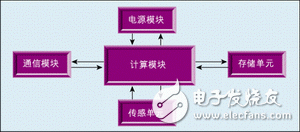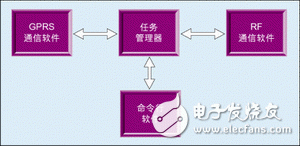With the development of technology, more and more applications based on distributed and wireless sensor networks. This paper presents a wireless sensor network experimental platform based on embedded system. The experimental platform has a good application prospect in the algorithm and protocol verification of wireless sensor networks.
The development of integrated circuits, MEMS and communication theory has prompted the emergence of wireless sensor networks. This wireless sensor network is made up of many self-contained sensor nodes. Each sensor node can collect ambient data, perform simple calculations, and communicate with other nodes and the outside world. The multi-node nature of the sensor network allows many sensors to work together for high-quality sensing and to form a fault-tolerant acquisition system. Because of these advantages, many distributed wireless sensor network applications have emerged in recent years, such as rescue and rescue, smart home and biochemical weapon attacks. 
However, as an emerging technology, building a well-functioning and robust wireless sensor network still faces many challenges. And because of its unique characteristics, the design method of wireless sensor networks is very different from the design method of existing wireless networks. For example, because of the dense distribution of sensor nodes in a sensor network, a wide range of data management and processing techniques are needed. Secondly, wireless sensor network nodes are generally deployed in areas that are difficult for humans to reach and contact, which makes the maintenance of sensor network nodes face great challenges. In addition, power consumption is also an important issue. Wireless sensor nodes, as tiny devices, can only be equipped with limited power supplies. In some applications, it is almost impossible to replace the power supply. This makes the life of the sensor node largely dependent on the life of the battery, so reducing power consumption to extend the life of the system is a top priority for wireless sensor network design. Many researchers in wireless sensor networks are focusing on new power-saving protocols and algorithms that require sensor network platforms for experimentation and verification. In this article, we will introduce a wireless sensor network platform that experiments and verifies protocols and algorithms.
Wireless sensor network platform architecture
In general, a wireless sensor network includes sensor nodes and sensor network gateway nodes, as shown in Figure 1. The gateway node is used to combine data obtained from various sensor nodes and to communicate with the outside world, the node being based on an embedded system.
The sensor node first collects environment-related data such as sound, light, and distance, and simply processes the data and transmits it to the gateway node. Wireless sensor networks typically have two application modes: active polling mode, passive mode. The active mode requires the gateway node to actively poll each sensor node to obtain a message, while the passive mode requires the gateway node to respond in time when a sensor node event occurs. The data obtained by each sensor node can also be combined, which greatly improves the efficiency of the sensor network. Of course, this also requires the sensor node to have a certain computing power.
System hardware implementation
In the system architecture introduced in this paper, the main need to implement the hardware platform of the sensor nodes and gateways, the hardware implementation of the two platforms is described below.
1. Hardware implementation of sensor nodes
The function of the sensor node is to collect data of interest to the person and send the data to the gateway of each sensor node group. The sensor node is mainly composed of a power module, a calculation module, a storage unit, a communication module and a sensing unit, as shown in FIG. 2 . 
The function of the sensor unit of the sensor node has been introduced in the previous section. In our system, TI's 16-bit microcontroller MSP430F149 is used. The MSP430 has a rich on-chip memory resource. At 5 MHz operating frequency, the MSP430 consumes approximately 1.5mW, and the microcontroller has a variety of power-saving modes to choose from. In addition to rich on-chip memory resources and multiple power-saving modes, the MSP430 has multiple AD interfaces and I/O data lines, making it easy to program in software. These interfaces can also be used as an interface to the sensing unit.
The function of the sensor module's communication module is implemented by the nRF903 RF transceiver. The transceiver's low power consumption and small size make it ideal for use in wireless sensor network systems that operate in common frequency bands such as 433MHz, 868MHz, and 915MHz. The RF module communicates with the MSP430 through the serial port. The nRF903 also determines the transmit power based on the input current. This feature gives it the following advantages:
a. It is possible to have one node automatically adjust the number of neighboring nodes for communication, thereby making the size of the entire network adjustable.
b. It is possible to have one node use less energy when communicating with relatively closer nodes.
c. Can be used to assist in collision detection of wireless channels.
d. Can be used to determine the relative position of a node in the network.
Each sensor node is powered by an AA battery.
2. Hardware implementation of the gateway
The hardware part of the gateway is mainly composed of a central processing unit, a storage unit, a radio frequency transceiver module and a GPRS communication module, as shown in FIG. 
The central processing unit of the gateway is mainly used to process the data collected from the sensor nodes and to perform some control functions. The main components of the central processing unit are Atmel's AT91RM9200 microprocessor, and the AT91RM9200 is an ARM processor based on the ARM920T instruction set. The processor's rich peripherals and interfaces allow it to perform feature-rich applications at low cost and low power. The AT91RM9200 processor integrates a number of peripheral interfaces, including a USB 2.0 interface and an Ethernet interface. In addition, the processor provides a number of industry-standard communication interfaces including audio, telecommunications, flash cards, infrared, smart card interfaces and more.
In order to transmit the collected data to the Internet, the gateway device is also equipped with a GPRS communication unit, which is mainly composed of a Sony-Ericsson GM47 module, which collects data from the sensor through the China Mobile GPRS network. On the transmitted Internet, users can observe the data collected by the sensor through ordinary PC and GPRS mobile terminal. The gateway is also equipped with the same RF transceiver module as the sensor node for accepting data sent by the sensor node.
System software structure
In our wireless sensor network system, the software part is mainly on the gateway and sensor nodes. The main function of the gateway software is to process and manage the data transmitted by the sensor node. It is mainly composed of GPRS communication software, RF communication software, command line software and task management software, as shown in Figure 4. 
Considering the various needs, we use the open source operating system - Linux. Linux is a networked operating system environment that is especially suited for web applications. Linux has a complete TCP/IP stack, and at the same time? ? ? Holding a variety of other network protocols, such as the PPP protocol stack, makes it easy to implement GPRS dialing. Due to the open source nature of Linux, users can easily develop their own applications on top of it.
The software on the sensor node is mainly developed in assembly and C language. The main function is to accept the data of the sensing unit and send the data to the gateway of the sensor node group.
Summary of this article
This paper introduces a wireless sensor network demonstration system for embedded systems. The whole system is based on embedded Linux and ARM processors, with low power consumption and easy development of software.
With the development of society and science and technology, wireless sensor networks will become more and more widely used. At present, wireless sensor networks are still insufficient in terms of energy and node scale. With the solution of these problems, wireless sensor networks will inevitably become more and more widely used in environmental monitoring, intelligent buildings and military fields.
Electrostatic Industrial Exhaust Gas Purifier
Electrostatic Air Cleaner,Electrostatic Exhaust Gas Filter,Electrostatic Industrial Exhaust Gas Purifier,Industrial Electrostatic Fume Filter
Dongguan V1 Environmental Technology Co., Ltd. , https://www.v1airpurifier.com